Porcelain Insulator News
By Elton Gish
Reprinted from "Crown Jewels of the Wire", October 2005, page 15
This month we will update you on a few interesting "finds" and
reports. The insulators covered will be both unipart (U-numbers) and multipart
(M-number)
styles. To start, I thought it would be worthwhile to discuss briefly the use of
Jack Tod's U-Chart as found in his book, Porcelain Insulator Guide Book. This is
the primary reference for unipart insulators. In addition to the U-Chart, the
book provides a detailed description of how insulators were made, manufacturer's
history, and markings that can be found on unipart porcelain insulators.
Many
people find using the U-Chart difficult. Most of these problems come from not
understanding what the U-Chart is actually showing you and how to use it. There
are relatively few CD numbers for glass insulators. Variations in a particular
basic style (like signal, beehive, etc.) are not assigned a different CD, but in
porcelain, a new U-number is often assigned when the differences are
significant. Often the differences are characteristic of a specific manufacturer
or identifies the dry process porcelain version. One exception is when the
difference is primarily due to the trimmer operation that cuts the profile.
Porcelain insulators are not pressed out in a mold, as were glass insulators.
The only exceptions are when the complete shape of the insulator (with cable
groove and/ or tie-wire groove) is cast in a mold or pressed in a two-part or
three-part mold. The later method was usually for dry process insulators and
certain smaller wet process porcelain styles made by Fred Locke and Pittsburg,
which usually have visible mold lines through the tie-wire groove or mold line
over the dome. Porcelain insulators that do not have mold lines had the profile
cut out by an operator manually swinging a shaped trimmer blade up against the
clay body as it rotates on a turntable. The trimming operation took no more than
one second.
The variability in profile of a specific insulator style could be
quite significant when you consider there could be different trimmer operators
and multiple trimmer lines. Additional variations in profile can occur when the
trimmer blade becomes worn, new trimmer blades or made, the mechanism that
swings the trimmer blade against the insulator becomes worn or misaligned, the
young trimmer's helper didn't set the clay body in the center of the turntable,
and probably other problems we haven't imagined. Then there are profile
differences between months or years of production and between different
manufacturers.
The greatest variability in profile, and consequently the most difficult area
in the U-Chart for collectors, is the section that covers the "signal"
style - U-228 to U-326. The next difficult area covers the small cable-top styles
- primarily U-438 to U-488.
Most people do not know that Jack Tod did NOT set up
the U-Chart from actual specimens, but rather from manufacturer's catalog
drawings. He did make drawings from actual specimens that were not represented
in catalogs he had available. Actual insulators produced by a specific company
did not necessarily match the catalog drawing profile very closely, especially
in the early years before the early 1920's. During this period manufacturers
could not turn out insulators fast enough and they had little concern over
producing a consistent product.
Remember, the dimensions shown for a specific
U-number can easily vary by +/- 1/4" and larger amounts as the size of
the insulator increases. Most of the questions I get concerning problems with
matching specimen in hand with the U-Chart is that the dimensions do not match.
The truth is the dimensions rarely will match exactly due to the reasons
explained above.
The primary thing you should look at when trying to identify and label your
insulator with the correct U-number is to determine the following in this order
(in declining importance):
- basic style (pony, exchange, signal, tramp,
cable-top, etc.
- single / double (1 inner skirt) or triple (2 inner skirts)
petticoat
- extended, flush or recessed inner skirt
- flat top, rounded, or
other shape of dome or crown top
- thickness (height) of the lower skirt
- profile of the lower skirt (slanted, vertical, rounded)
- cable groove or
tie-wire groove width
- upper wire ridge profile and thickness
|
Putting all this in words sounds complicated. It is about the same thing you
do to ID a CD number, just you have fewer CD numbers to select from. There are
over 1000 U-numbers. The U-Chart is logically laid out in order of basic styles:
pony, exchange, mine, tramp, signals, cable-tops without petticoats, double
petticoat, triple petticoat, high-tops, side petticoats, large styles, with the
last section reserved for glazeweld, very early classics, and threadless. If you
find a U-number close to what you have, do not get frustrated that it doesn't
match exactly, because odds are few insulators will match exactly. For example,
the photo of two U-250's illustrates the variability introduced by the trimming
operation. Note the differences between the two insulators compared with the
U-number drawing. If you think the variability is too great, simply call it
Sim-U-250. That is close enough. If you give that description to someone else or
put it on a sale list, others will know pretty much what you are talking about.
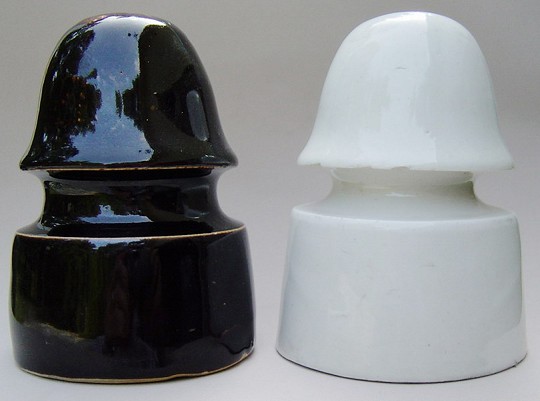 |
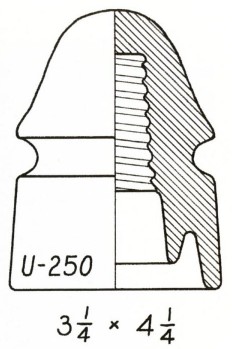 |
|
Two U-250's showing variability due to trimming. |
Now to something more interesting n the new reports. Marty Caverly sent the
following photo of his U-239 and U-191. These were made of dry process porcelain
by R. Thomas & Sons Co. circa 1910. The glaze is a greenish gray in the
thicker areas and the tops of the domes are "carved". Actually the top
of the mold was carved, which leaves multiple flat areas as if the insulator
itself was carved. This is a characteristic of Thomas dry process porcelain made
through the 1910's. Both insulators were made in a 3-part mold. The body of the
insulator with side cable groove was made in two halves of the mold with the top
up from the upper wire ridge being the third part. I have one specimen of U-239
with almost no color in the glaze. Some specimens have a much more pronounced
green color. Note the crude, porous nature of the porcelain. There are several
"carved-top" styles. The greenish-gray U-191 is the rarest with less
than 10 reported. Most have been reported coming out of Michigan.
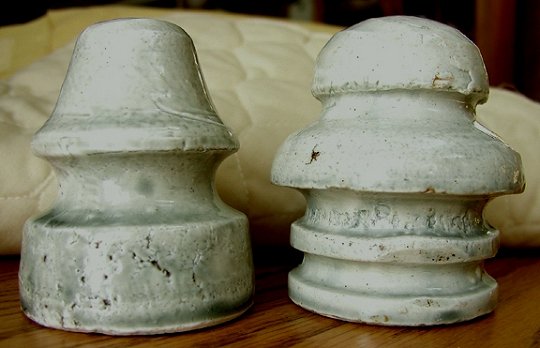
Unmarked greenish-gray Thomas U-239 and U-191.
Apparently Locke was trying to compete with the cheap line of Thomas-made dry
process insulators. Ken Willick reported finding a broken specimen of U-169 in
the Victor dump. It was made of dry process porcelain with the large incuse
Victor R=oo insulator logo marking and the glaze was bluish-gray.
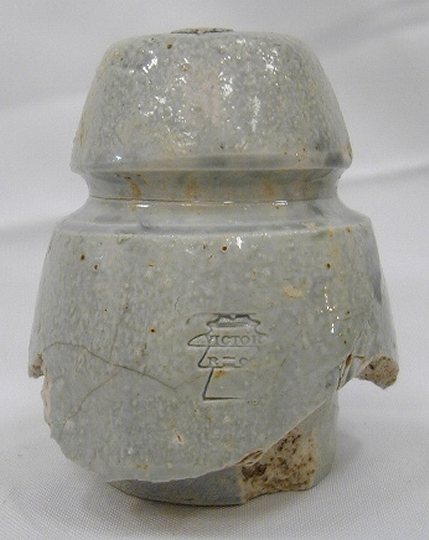 |
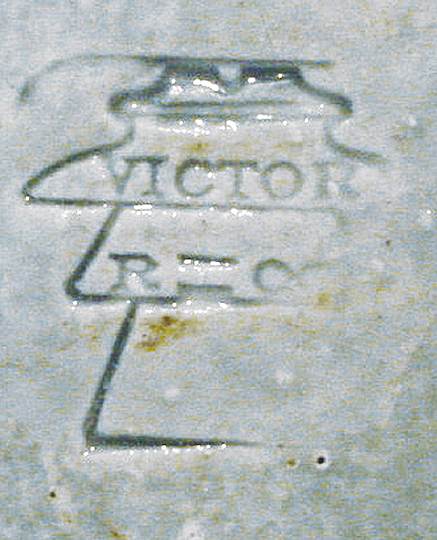 |
|
Bluish-gray U-169 found in the Victor dump. Note the very porous dry process
porcelain. |
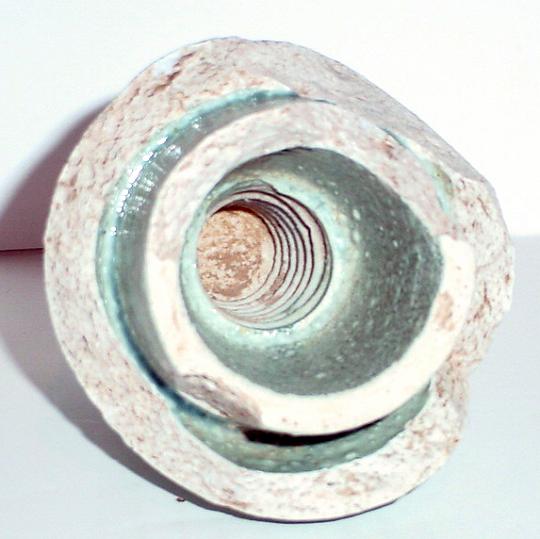
If you missed the San Jose National show this year, you missed a wonderful
display by Barbara Smith and Carver Mead. Their collaborator, Alonso Rodriguez,
recovered two incredible multiparts from the Guanajuato line in Mexico. The line
was constructed in 1903 using Fred Locke M-3725's. The top insulator on the
towers was vulnerable to lightning damage. The line was upgraded in 1906 by
moving the top insulator below the double crossarm and running a grounded wire
at the top. The insulators were also replaced with larger Thomas 3-part
insulators. Alonso recovered one M-3990 (18 - 13 - 11 x 20.5) and one similar
insulator that was assigned a new M-number. No specimens of either insulator
have ever been reported. M-3990 was shown in the early Thomas catalogs. The new
style is M-3940 (15 - 12.5 - 10.5 x 20). Note the smaller diameter top shell
with unique style of crown that appears to be an improvement over M-3990 by
strengthening the crown to make it less prone to damage. Both insulators have
the period Thomas glaze that is reddish brown with drippy mustard in places. The
top shell of M-3990 is mostly mustard colored!! The bottom two shells are nearly
the same.
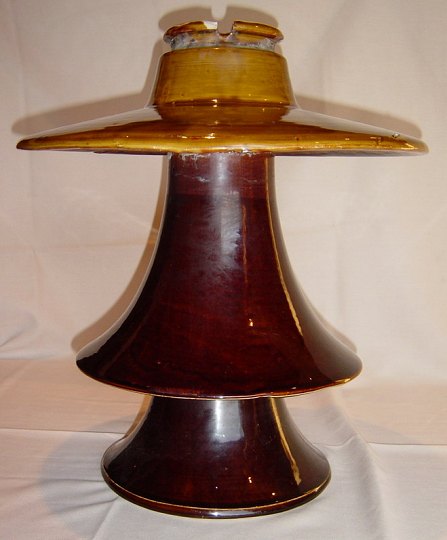 |
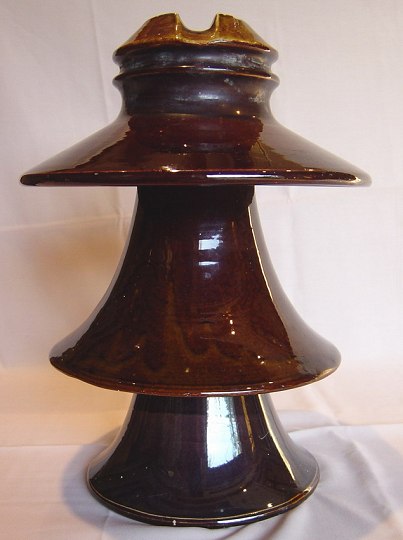 |
|
Thomas M-3990 and M-3940 from the Guanajuato line in Mexico. |
You probably think that only glass insulators have drip points. Bet you
didn't know that some porcelain insulators had drip points, too. How about a
Fred Locke U-608A with "drip points"? Bill Rohde proudly displayed
this unique specimen at the San Jose National. There are five rather large black
"drips" along the outer skirt edge making a nice contrast to the
caramel-colored glaze. I have the cousin to Bill's insulator. My U-608A has the
same glaze coloring, but only one thick, black drip. Do any of you have a
similar insulator with "drip points"?
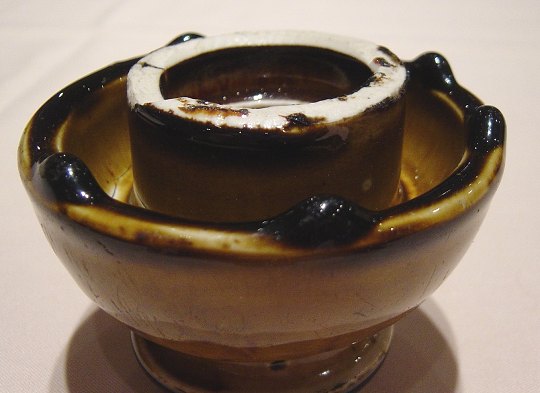
Fred Locke U-608A with five large, thick, black "drip points".
|
